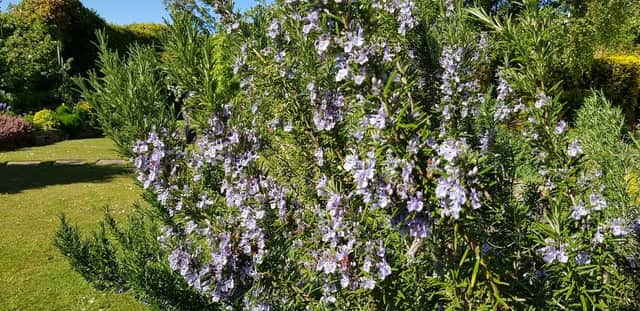GARDENING: The perfect companions in lockdown


Oh, the joy of spending long hours in the presence of old friends whose entertainment value is spot on at this time of year. And yes, we are getting up close-up to them and personal without breaking any government guidelines. I refer to favourite perennial plants of course. There are strong elements of permanence and reassurance in their presence.
Not that the large, double white blooms of lilac (Syringa vulgaris `Madame Lemoine`) need such close contact to appreciate their stunning fragrance, it carries naturally across the lawn. This is an old variety beloved of cottage gardens and it came from an enthusiastic neighbour ages ago.
Advertisement
Hide AdAdvertisement
Hide AdOnce he realised that the suckers emanating from the tall parent plant in his garden were reproducing true to form, he ensured that several other households down the lane received the double white beauty. In this respect his legacy lives on.
Whichever colour of lilac is chosen, there are reds, purples, pinks,
lavender, and yellows, be prepared for three metres or so of growth over time.
It can take severe pruning that might delay flowering for a season but
Advertisement
Hide AdAdvertisement
Hide Adrejuvenates the tree. We also have a dwarf Korean lilac (S. velutina) that is a bushy form barely over one metre tall. It has lavender-pink blooms in May that repeat in September. It`s ideal for a smaller garden.
Spiraea `Arguta` is the bridal wreath. It currently has long arching branches covered in clusters of pure white flowers along their length. There is no fragrance to speak of but oh the form. What a statement it is making in the mixed border. Propagation time is in the autumn when hard-wood cuttings from summer growth are planted upright in the garden and left to root. I use the bare twigs to support the flower stems of forced hyacinth bulbs, planted in bowls over winter. And guess what? Given the warmth and watering, buds, shoots, and roots develop on the spiraea supports. An unexpected bonus.
Throughout the garden we have pockets of Rosemary `Jessop`s Upright` and they all came from the original plant which is still growing strongly. It flowers in bursts of blue from May to October and is constantly offering softwood stem cuttings. Having rosemary by a pathway is a win – win situation. Apart from the attractive clusters of bloom there is the familiar herby fragrance as a branch is lightly grasped and slides through the hand as we walk past, and it is useful in the kitchen.
Our current star attraction is a Californian lilac (Ceanothus `Concha`).
Advertisement
Hide AdAdvertisement
Hide AdAbsolutely smothered in blue flowers, it`s in standard form circa two metres high. Close inspection of the dazzling blooms and diversity of bee/butterfly species it attracts is a must. The eventual removal of spent blooms encourages new growth, some of which can be rooted as soft stem cuttings, the remainder will surprise us with a display of autumn flowers.
These are but some of the plants we`ve chosen over time to be constant companions in the garden. As I look around the local area it is evident that we are not alone in this. There are cultivars of the pink Clematis montana in glorious full bloom draped over fences, climbing up walls and scrambling over sheds. Long, golden panicles of laburnum flowers are dangling from trees in gardens that until recently were not given a second glance by those who passed by. These and many other woody perennials have the potential to lift our spirits, strengthen our resolve and guide us through a very trying time.
Anticipating the flowering or maturity of any plant be it an ornamental, fruit, or vegetable, is an absorbing part of the gardening process. The sowing of seed represents a challenge unfulfilled until the subject reaches maturity.
It must be five years since friend Jaci gifted three hard, shiny black seeds of thumb-nail proportion that she`d saved from a tree paeony in her garden.
Advertisement
Hide AdAdvertisement
Hide AdThey were consequently given frost treatment then sown and took weeks to germinate. After potting-up and hardening-off, two young plants were added to a mixed border. Last May, large yellow blooms appeared for the first time and they were followed by impressive seed capsules whose contents are currently in the propagating box. How satisfying is that? When the local Lionheart Radio station was declared out of bounds, rather than postpone our Weekending Show, friend Carl and I decided to pre-record it, as other broadcasters are doing. So, Top birder Tom Cadwallender, Rivers Authority specialist Steve Lowe, and I, send our weekly contributions to Carl who miraculously formulates a one-hour programme. It`s broadcast on
Saturday afternoons from 2pm to 3pm on 107.3 FM or live online at
www.lionheartradio.com. Alternatively, visit our podcast The Nature Garden.